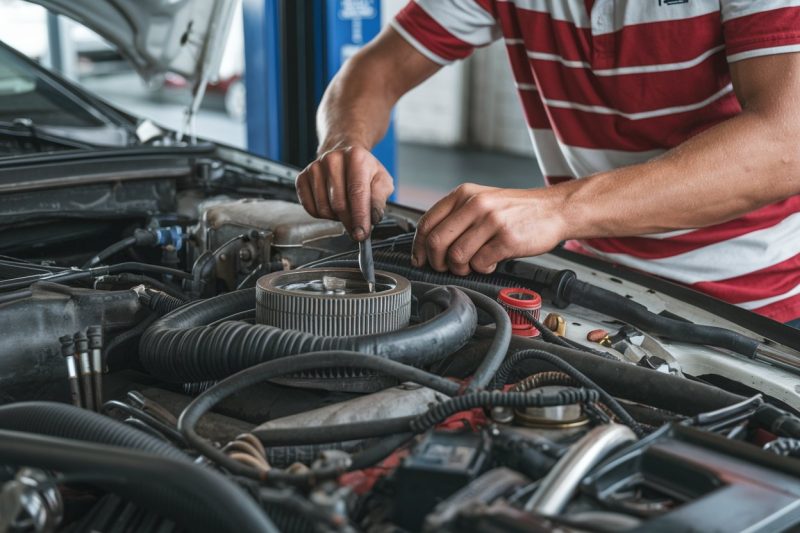Owning a car comes with the responsibility of keeping it in good working condition. It’s not just about getting from point A to point B; it’s about ensuring your vehicle remains safe and reliable. One way to do this is by spotting common car problems early, before they turn into expensive repairs. Knowing what to look for can save you a lot of money and stress.
Unexpected car issues often start with subtle signs that are easy to overlook. For instance, you might hear a strange noise coming from under the hood or notice a new warning light on your dashboard. These are not just annoyances; they are the first clues that your car is trying to tell you something is wrong. Addressing these signs promptly can prevent further damage and higher repair costs.
Another aspect to watch for is changes in the way your car drives. Vibrations, pulling to one side, or a rough ride can all indicate underlying problems that need attention. By being alert to these symptoms, you can catch issues early and keep your car running smoothly. Keep reading to learn how to identify these common warning signs and what they might mean for your vehicle.
Recognizing Unusual Engine Noises
Table of Contents
- 1 Recognizing Unusual Engine Noises
- 2 Dashboard Warning Lights and Their Meanings
- 3 Spotting Fluid Leaks and What They Indicate
- 4 Changes in Driving Experience
- 5 Frequently Asked Questions
- 6 1. What are some common car problems I should be aware of?
- 7 2. How can I spot potential car problems before they become serious?
- 8 4. What are some common car problems I should be aware of?
- 9 5. How can I spot common engine issues before they become major problems?
Engine noises can tell you a lot about what’s happening under the hood. One common noise is a knocking or pinging sound, which often signals problems with the ignition system or fuel quality. This could mean the fuel isn’t burning properly, or the spark plugs might be worn out. Ignoring this noise can lead to serious engine damage over time.
Another noise to be aware of is a squealing sound, which often comes from the belts in the engine. This could mean the serpentine belt or timing belt is loose or worn. If left unchecked, a broken belt can lead to major engine failure. A hissing noise might indicate a coolant leak or vacuum leak. This noise usually comes after the engine has been running and indicates that air or fluid is escaping from somewhere it shouldn’t be.
Differentiating between harmless and serious sounds can save you from unnecessary worry or repairs. For instance, a light ticking noise when you start your car could be harmless, especially if it goes away after a few seconds. However, continuous or loud ticking likely requires attention. If you’re unsure, it’s always best to consult a professional to diagnose the issue.
Dashboard Warning Lights and Their Meanings
Dashboard warning lights are your car’s way of telling you something needs attention. Here are some common warning lights you might see:
1. Check Engine Light (CEL): This light can indicate a range of issues from a loose gas cap to serious engine problems. It’s important to get it checked out as soon as possible.
2. Oil Pressure Light: When this light comes on, it means your engine is low on oil or experiencing low oil pressure. Continuing to drive with this light on can severely damage your engine.
3. Battery Light: This indicates an issue with your car’s charging system. It could be a problem with the battery, alternator, or wiring.
4. Brake Warning Light: This can indicate low brake fluid or an issue with the braking system. If this comes on while driving, pull over safely and check the brakes.
When any of these lights come on, take immediate action. For the check engine light, it’s wise to use an OBD-II scanner if you have one, to get a code before visiting a mechanic. For oil and battery lights, check the levels or connections if you’re able to. For the brake light, inspect the brake fluid level and brake system for visible issues. Ignoring these warning signs can lead to more costly repairs, so it’s essential to address them promptly.
Spotting Fluid Leaks and What They Indicate
Fluid leaks are a clear sign that something might be wrong with your car. Each type of fluid has a specific color, making it easier to identify the source of the leak. Transmission fluid is typically red or pink. If you notice a red puddle under your car, it might indicate a transmission leak, which can lead to serious mechanical damage if not addressed.
Coolant is usually green, yellow, or orange and has a sweet smell. Leaking coolant suggests a problem with your car’s cooling system, like a damaged radiator or hose. Ignoring this can cause the engine to overheat, resulting in costly repairs. Motor oil is amber when new but gets darker as it ages. A dark brown or black puddle could mean an oil leak, which can affect your engine’s performance and lead to substantial damage.
Brake fluid is clear to brownish and has a distinct smell. If you see a clear to brown leak near your wheels, it might be brake fluid, and a leak here can compromise your car’s braking ability, posing a serious safety risk. Power steering fluid is often reddish or light brown. A leak could make steering difficult and unsafe.
Changes in Driving Experience
Changes in the way your car drives can be significant indicators of underlying issues. If you feel vibrations while driving, it might indicate problems with the tires, wheels, or alignment. Vibrations can stem from uneven tire wear, unbalanced wheels, or a failing suspension system.
Pulling to one side while driving or braking can also indicate alignment or brake issues. This might mean your car’s alignment is off, your brakes are unevenly worn, or there could be a stuck brake caliper. Ignoring these issues can lead to uneven tire wear and reduced safety.
Conclusion
Keeping an eye out for common car problems can save you time, money, and stress. Recognizing unusual engine noises, understanding dashboard warning lights, identifying fluid leaks, and noticing changes in driving experience are all critical steps in maintaining your vehicle’s health. These techniques help you spot issues before they escalate into costly repairs.
Taking immediate action when you spot these signs can keep your car running smoothly and safely. Sometimes, simple maintenance and timely repairs are enough to prevent major problems. However, don’t hesitate to seek professional help when needed. Regular inspections and check-ups from a trusted mechanic can identify and fix issues you might miss.
For expert auto repair and maintenance Woodstock services, visit My Mechanic Joe in Woodstock, GA. Our skilled technicians are ready to help keep your car in peak condition. Schedule an appointment today and ensure your vehicle gets the care it deserves.
Frequently Asked Questions
1. What are some common car problems I should be aware of?
As a car owner, it’s essential to stay vigilant and be aware of common problems that can affect your vehicle. Some of the most common car problems include:
- Electrical problems (faulty battery, alternator issues)
- Engine misfires or rough idling
- Transmission issues
- Brake system problems
- Suspension and steering concerns
- Coolant system failures
- Oil leaks
- Corrosion and rust
Being aware of these issues can help you spot common red flags and address them before they lead to costly repairs.
2. How can I spot potential car problems before they become serious?
To spot potential problems in your vehicle, follow these tips for spotting:
- Pay attention to unusual noises, vibrations, or smells
- Monitor your dashboard warning lights
- Regularly check fluid levels and condition
- Observe changes in fuel efficiency
- Inspect your tires for uneven wear
- Be aware of changes in your car’s handling
- Keep track of your vehicle’s performance
By staying attentive to these aspects, you can identify issues early and avoid costly repairs.
3. What should I look for when inspecting a used car?
When buying a used car, it’s crucial to thoroughly inspect the vehicle. Here are some key areas to check:
- A rough ride, characterized by excessive bouncing or swaying, can suggest suspension problems. Worn shocks or struts often cause this. The suspension system is crucial for vehicle stability and comfort, so any signs of trouble here should be addressed promptly.
When you notice these changes, it’s essential to seek professional help. Driving with these issues can be dangerous and lead to more extensive damage down the line. Early intervention can save you from more significant problems and ensure your car is safe to drive.
Here’s an extended FAQ with 10 common questions and long-form answers for “Tips for Spotting Common Car Problems Before They Cost You Big” in HTML format:
4. What are some common car problems I should be aware of?
As a car owner, it’s essential to stay vigilant and be aware of common problems that can arise. Some of the most common car problems include:
- Electrical problems such as battery issues or faulty alternators
- Engine misfires or rough idling
- Brake system issues, including worn brake pads or warped rotors
- Transmission problems, such as slipping gears or delayed engagement
- Suspension issues, like worn shocks or struts
- Exhaust system leaks or damage
- Corrosion and rust, especially in older vehicles
Being able to spot these potential car problems early can help you avoid costly repairs down the road.
5. How can I spot common engine issues before they become major problems?
To spot common engine issues, pay attention to the following red flags:
- Unusual noises, such as knocking, ticking, or rattling
- Decreased fuel efficiency or increased oil consumption
- Vibrations while idling or accelerating
- Check engine light or other warning lights on your dashboard
- Blue or white smoke from the exhaust
- Reduced engine performance or power
If you notice any of these signs, it’s crucial to have your car inspected by a qualified mechanic to prevent engine damage and costly repairs.

